Any event happening in Marfa is a good excuse to venture to the small West Texas town. Sure, if you visit during one of its surprisingly many busy weekends — Chinati Weekend, the Trans-Pecos Festival, the Agave Festival, etc. — you may not get the genuine, charming, small-town Marfa experience. However, the upside of a trek west during these times is that everyone is rearing and ready to go. No one is on a month-long vacation; galleries and shops tend to stick to semi-regular hours; and, if you’ve gotten to know anyone who lives there, you can commiserate with them about the influx of yuppies who have never heard of Donald Judd.
One such weekend happened earlier this month. For the fourth edition of the Marfa Invitational art fair, which has planted its flag in the first weekend of May, gallerists, artists, and even a few collectors descended on the town to get a piece of West Texas action. Throughout the weekend there were cocktails, dinners, a screening of The Art of Making It, and a talk by Jerry Saltz, who is one of the art world’s most famous exports.
I made the ten-hour drive out west for the fair — my first visit to the now annual event — to see what it was about. Below, find a travelog of sorts, full of art, thoughts, and, perhaps most importantly, Marfa food recommendations.
Over the years, my annual pilgrimage to Marfa has slightly changed. While the first couple of times I made the drive on I10 from Houston, stopping in the increasingly spread-out towns along the way, and perhaps most memorably visiting the Caverns of Sonora (a must-see for cave lovers), I now tend to favor the southern route. This jaunt takes you straight west, through San Antonio, Hondo, and Uvalde, and on to Del Rio, before jutting up and kissing the border along Texas’ armpit. The views are different from the I10 route — fewer, but more spectacular and sudden.
I rolled into town Thursday eve, stopping first at Para Llevar, a new-ish, trusty and quick eatery. The main event this evening was the fair’s preview, capped off by a cocktail party for exhibitors, artists, and VIPs. Both events were in the Saint George Hall, an event space smack dab in the center of town owned by the Hotel Saint George, which is oftentimes the preferred lodging for hip out-of-towners.
Before hitting the fair, I stopped in at Do Right Hall, the former home of Buck Johnson and Camp Bosworth’s Wrong Store, to see Latino de Luz, a show by artist Miguel Valverde. The Hall has a history — it hails from 1886 and was the town’s first church. The show featured a number of paintings and sculptures, but its most striking piece was a large LED heart, which hung on the back wall of the space, where an altar should have been. In the waning light, it cast a warm red glow on the church’s interior, completely transforming the clean, white space. Later in the night, the light emanated out of the building’s large, street-facing window, projecting an uneasiness into the neighborhood.
On Friday, the real events began. After a breakfast at Aster (some of the best pastries and baked goods in Texas, bar none), I headed to Saint George Hall’s patio for a talk by Jerry Saltz. A crowd quickly filled in, sitting at long, Judd-like picnic tables. For his lecture, Saltz played the hits — he mimed looking at art, he talked about the raw power of cave paintings, and he called the audience babies. The talk was different, however, from many other lectures I’ve watched or podcast appearances by him I’ve listened to. This is partly because he made, at least the beginning, personal — he spoke about Marfa, about El Paso, and about Donald Judd. About the power of what it means to have everyone visiting the town, about what it means for an artist to essentially take over a place, and how that ties into the art world today. Saltz’s talk was compact, comedic, and cogent — a cool 45 minutes that, perfectly, left everyone wanting just a little more.
After Saltz’s talk, it was time to pop around town. I visited the Wrong Store proper, which is now on Highland St., the town’s north-south thoroughfare, to see Krissy Teegerstrom’s show of capes. Each is meticulously handmade without seeming precious; high and low — sequins, velvet, satin, award ribbons, and other materials — come together to create appealing garments, some hooded and some not. These pieces are decorative yet functional; nice enough to hang on the wall, but not too special to wear on a night out on the town. It has been nice to see the progression of Teegerstrom’s work — I first stumbled upon it in 2021 at Bale Creek Allen Gallery in Austin. Since then, she’s just been getting better.
Lunch can be hard to find in Marfa. The previous go-to spot, Food Shark, has closed down (along with it went, surprisingly, some of the best falafel I’ve ever had), and the last time I visited it was slim pickings. Cue Bordo, a new Italian deli which has opened on the west side of town. The menu is simple: sandwiches, pastas, and gelato, all unfussy and made with high-quality ingredients. The service was kind and quick and the food was fantastic — I hope to revisit this wonderful spot for many years to come.
After lunch was more looking around town. Christopher Blay, Glasstire’s former News Editor and the current Chief Curator at the Houston Museum of African American Culture, had a pop-up installation of work in a still-being-built studio building across the street from the Big Bend Sentiel’s coffee shop. He was showing his SpLaVCeShip, a combined, imagined, slave-ship-rocket-ship hybrid, which first made an appearance last year at Barry Whistler Gallery in Dallas. This sculpture, along with other cyanotype and mixed media works, sat well in the unfinished, concrete block space; it gave off an air of both raw potential and of confinement — dueling feelings that are echoed in Blay’s artwork.
Around the corner, in the lobby of the wonderful Crowley Theater, Santa Fe gallery Gerald Peters Contemporary had installed a show of work by Elizabeth Hohimer. The sculptures and weavings fit both the aesthetic and the feel of the West Texas desert — many were made from natural materials, including dyed cotton, silk, and ash. The works had a texture that required close, thoughtful looking. Each piece was well-crafted and demonstrated a respect for, inquiry of, and thoughtfulness about land — these are earthworks on a gallery-scale.
Next up was Marfa Open, which was hosting a collaborative exhibition by artists Tim Kerr and Robert Hodge. While looking at the show I met Seph Itz, who runs the organization. He talked about the history of the building (which used to be a train depot), about the Marfa Open Artist in Residence program (which invites artists to come to the town for a two-to-four week period and create work), and about the Marfa Open Art Festival, which happens every fall. I was glad to get a preview of Kerr and Hodge’s collaborations before they hit Houston — their pop-up show No Kinds But Us just opened at the Blaffer Art Museum, and will be on view through June 4.
Later in the day marked the opening for two shows: Andrea Heimer at Nino Mier Gallery, and the group exhibition Vision Pool at Eugene Binder. Heimer’s exhibition features flat, narrative-like paintings that fit right into West Texas’ cowboy mythos. Though the works were inspired by the artist’s growing up in Montana, you can’t help but project a Texan sensibility onto their cowboys, corrals, duck hunting, and barn weddings. The paintings do attempt to correct the record — most have a long, narrative title, laying out exactly what memory Heimer is pulling on within the piece. Other paintings and drawings, which instead take up descriptive titles, are more playful and illustrative — in one, a group of naked cowboys dances around a rock formation-filled desert.
In Vision Pool, Binder curated a wet, hot show for our dry summer. A wall of lush, semi-figurative oil on canvas abstractions by Raychael Stine faces off with a wall of Pool Party paintings, which are enamel, polyurethane and spray paint on aluminum abstractions by John Pomara (fittingly, Stine was a student of Pomara’s at the University of Texas at Dallas). Other pieces — all paintings of sorts — by Jeff Elrod, Jonathan Lasker, and Zeke Williams round out the space. A 2023 photograph by Bob Anderson, of water from the Pacific Ocean, is perhaps the most overtly water-themed piece in the show. But still, it abstracts its subject just enough to become washy, a composition made of blue, black, and white.
Saturday started with a quintessential element of any Marfa visit — a trip to Julie Speed’s studio, which is housed in the old Fort D. A. Russell jail, just outside the edge of the Chinati Foundation’s campus. Walking across the threshold of Speed’s property — past her dry stack stone wall and to her studio buildings — is a delightful experience. You’re greeted by thriving plants, flowers, a cute courtyard, and a fantastic view of Donald Judd’s 15 untitled works in concrete, which lay in the distance beyond her backyard.
Speed is always working on something new. Her L-shaped studio is normally split into three areas — a clean, gallery-like presentation of new work, an interim area, sometimes filled with old work and sometimes with new, and a dirty work space, which is populated with old work but is also home to in-progress paintings, sculptures, ideas, and other projects. This time around, the clean space featured large-scale works on board, many of which centered her iconic, unsettling characters, which were combined with collage elements made of old etchings and engravings. One thing I love about Speed is her penchant for archiving and publishing — her new series is documented in a staple-bound book called Changeling. Nearly every artwork in the 55-page publication is from the last two years, showing the artist’s tenacity when it comes to her production.
Next I made a visit to the Marfa Book Company, which for the past few years has been located just a few blocks southwest of the town’s main intersection. In addition to having a wonderful, tight selection of new and used art books, novels, and poetry, the shop’s standalone space (it used to be located in the lobby of the Hotel Saint George) devotes about half of its square footage to exhibitions.
This weekend the show was by Kate Newby, a 2018 Chinati artist-in-residence from New Zealand who now lives and works in Texas. The show seemed simple in appearance, but rewarded close thoughtful looking: the Book Company’s windows had been replaced with frosted, holey panes, letting in the sun and the desert sand. In the front of the gallery space sat a rusted pedestal filled with ceramic sculptures. These works could’ve been displayed on evenly-hung shelves around the gallery, or on bespoke wooden or white pedestals, but instead they were clumped together, fighting for space and with one another. But this choice worked — taken together, the pieces looked like elements of a barrier reef, each with their own texture, color, and purpose, interacting and forming symbiotic relationships. They belong in a group because they need the context — not because any individual piece is weak (they’re all actually very strong), but because their individualities feed off of one another.
After grabbing a quick bite at Marfa Burrito (another delightful and fairly consistently open lunch spot — cash only!), I headed to Marfa artist Laszlo Thorsen-Nagel’s open studio. I first met Thorsen-Nagel in 2015 during Chinati Weekend — that was at least two studios ago, and when he was relatively new to town. Since settling in Marfa, he’s focused on honing his craft, which is quite specifically abstract paintings made using brushes, sumi ink, and, more recently, custom-made colored pigments. There’s a wonderful tiling that can happen with his small-scale pieces, many of which sit on a table or shelf top in his studio — because of Thorsen-Nagel’s consistent but varied style, they go well together, reminding me of a Margo Sawyer installation.
The artist’s newest works forgo his traditional white-primed surfaces for black ones. This means the pieces are moodier and ominous. Polished and unpolished black sumi ink washes overlap with one another, giving off subtleties that sing in good light, like that coming from Thorsen-Nagel’s north-facing studio windows. In another piece, a rich blue, which fades into magenta, frames a polished black surface, which itself acts like a fogged mirror for anything in its view. These are developments that will serve Thorsen-Nagel well — he’s still exploring his simple, time-honored material, but he’s doing so in a way that’s new to him and yielding thoughtful and surprising results.
I was glad to be in Marfa to catch the very last day of Kenneth Tam’s exhibition at Ballroom Marfa. Works commissioned for the exhibition — a suite of sculptures and a two-channel video — explore the complicated reality of America’s westward expansion. There’s a tendency of people — artists, gallerists, other visitors — who visit Marfa to fall into the trap of cowboy cosplay. The most serious offense is when someone who has never been to the town before comes with new clothes in hand — a hat with a turquoise band, a big belt buckle, boots, jeans, and a pearl-buttoned shirt — and wears them around as if they are a rancher. (Note: though stereotypical, this isn’t how ranchers dress.) Other offenses include buying a $120 hat that you’ll never wear again, making cowboy art because you think it’s what the audience wants, and slipping into a southern drawl that doesn’t quite fit the region. The trap is partly a situation of place — for most artists, a West Texas environment is alien, so every approach of interrogating it seems new and exciting, even though it is likely well-trodden.
Tam’s show, in his investigation of Chinese laborers who built the Transcontinental Railroad, managed a fresh perspective. His videos have always been standouts, looking at how people (oftentimes men) behave and navigate the world. Silent Spikes, the video on view at Ballroom, is all at once tender, poignant, and absurd. A fair portion of its power comes straight from a critique of cowboy cosplay — instead of taking it seriously, Tam uses images of Asian men dressed in ranch hand regalia to complicate what we think of as masculine, as Texan, and as Western.
Next up was a stop at Marfa’s newest gallery space, ¿Tierra y Qué? Gallery, run by Mateo and Malinda Galindo. Installed in an adobe walled building, which used to be an auto parts shop, is a show of works by Livia Corona, Andres Janacua, Suzanne Kite, Steven Yazzie, and Nathan Young. Janacua’s layered, black and white vinyl works were patterns galore, and Young’s broadcloth banners were particular stand-outs. Outside of the gallery is a disguised artwork, a faux real estate sign by Yazzie. If an interested party calls the number, they get a lesson in colonization, land use, and development — a poignant undercutting of expectations, particularly in a real estate hotzone like Marfa. I’m excited to see what the Galindos have in store for this space next.
For a pre-dinner snack, I stopped off at Convenience West, which I’d argue is one of the best BBQ shacks in Texas. They’re only open two days a week, but whenever I’m in Marfa their meat and sides are a prerequisite meal. Then, early in the evening, I went by Rule Gallery to see the opening of Denver-based artist Diego Rodriguez-Warner’s solo exhibition. The artist’s paintings feel minimal and maximal at the same time: figures, some brightly colored and some in black and white, intertwine and dance across his panels’ surfaces. The works are highly polished in some areas, and rough-hewn in others — certain sections are carved out, as if he was preparing the panel to be a woodblock for printing. The pieces are technically on point; Rodriguez-Warner is clearly a master of his mediums, and has found a way to use them in a smart, but restrained way to create paintings that buzz with energy.
As the sun began to sink, I went out to the grounds of the eventual Marfa Invitational Foundation site, just east of town, where a BBQ dinner and an installation of sculptures had been organized. In the magic light of the dusty, shrubby desert, two works stood out: BOD, a new, seven-foot-tall, fleshly pink cast aluminum sculpture by Polly Borland, and Roll Gate, a 2022 piece by Charles Harlan. When seen up close, BOD appears perfectly executed — it looks as if a figure is trapped inside, straining to get out. The work is expertly made; its surface comes across as latex stretched over a form. Though the piece doesn’t dominate the landscape from afar (the works were vaguely viewable from the highway into town, with the most visible piece being a literal billboard), up close it is unsettling and fascinating.
Backed by a sun-streaked sky, Roll Gate was perfect in its uncanniness. The work is systematically out of place — some residents of Marfa don’t even lock their doors, so the concept of a roll gate on a business is absolutely foreign. Even so, here it is further removed from the town, or from any humanity. It is uselessly languishing in the desert, locked but guarding nothing. I had at first thought the piece was by Alvaro Barrington, who had installed similar works in and around Karma gallery in New York City earlier this year. I think, however, because of its setting alone, Harlan’s gate had a stronger resonance.
Saturday night capped off with a happenstance experience that was uniquely Marfa: an acquaintance of Austin artist Jenn Hassin, who was a new Marfa friend, who I had previously run into and briefly met, had an extra ticket to a Star Party at the McDonald Observatory in Fort Davis. After a little schedule jiggering, I quickly accepted the ticket and joined the group. After zigzagging up a mountain, you come upon the dimly lit visitor center. Then, you make your way to a circular amphitheater, where the show begins. An astronomer uses a powerful laser pointer to give you a tour of the night sky in all its brilliance. You see satellites careening across the horizon, shooting stars, and more constellations than you ever have before. Then, the group breaks up and everyone goes to look at specific star clusters and planets through the observatory’s telescopes. It’s a magical experience in a magical place, and may very well be the best thing any person can do in West Texas.

Colored pencil on canvas works by Samantha Rosenwald, on view at Room 57 Gallery’s presentation at the Marfa Invitational
Sunday was the last full day of festivities, but it was still brimming with energy. I started the morning out at the Invitational — I like walking through art fairs when they’re a little slow, so I actually have a chance to see the art. Room 57 Gallery from New York had a nice display of colored pencil on canvas works by Samantha Rosenwald. Their technical skill — even up close it was hard to discern the artist’s individual strokes — and their humor undid some of the cowboy cosplay they emanated. Big belt buckles, bandoliers, and bolo ties populate the works, but their cartoonish style undercuts the seriousness of the figures’ trappings. Stitched canvas pieces by Heather Day at The Pit blended in with the Marfa vibe: bright bursts of color jutted up against each other and were punctuated by swaths of blank canvas — activity and rest; build up and release; energy and stillness.
Baldwin Gallery won the brightest booth award with a show of dayglo works by Peter Halley. The paintings were physically hard to look at — the color vibrations in them were jarring, but at the same time I couldn’t turn away. Each work was modestly sized and, in a very overt but abstract way, depicted a prison window. I normally feel that Halley is best when he cuts loose and produces large-scale works, but these made sense for the Invitation and for Marfa — one could only think of old-timey West Texas jails. In this case, were we locked up and looking out, or were we the warden, surrounded on all sides by unseen prisoners?
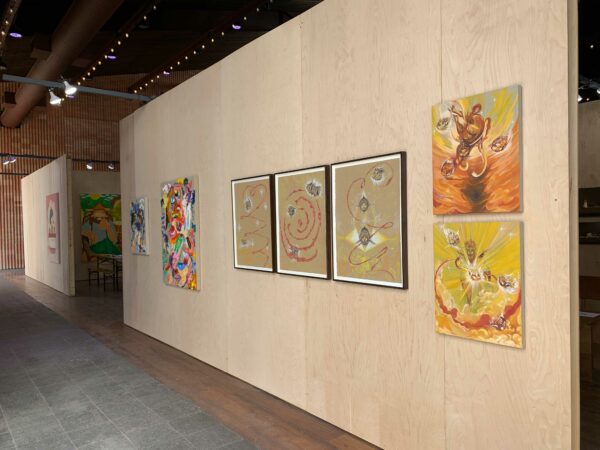
Drawings and paintings by Asif Hoque, on view at Half Gallery’s presentation at the Marfa Invitational
The outer wall of Half Gallery’s booth had a selection of three drawings and two paintings by Brooklyn-based artist Asif Hoque. The drawings feel out of the baroque tradition — on a brown ground, cherub-like figures, which looked like a Snitch from Harry Potter, but with a face, fluttered around swirling compositions. Red, yellow, white, and gold are Hoque’s colors; these pieces feel old and ancient, but with a contemporary sensibility. Perhaps the best way to describe them is to say they’re bastardized old master drawings, but if the master had been on acid.
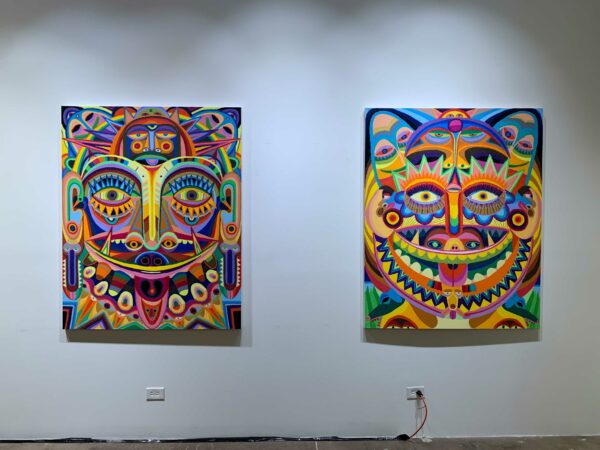
Oil pastel on canvas works in Sam Schonzeit’s exhibition at Hey I Like it Here in the Hotel Saint George
After walking through the fair I went across the street to the Hotel Saint George to see Sam Schonzeit’s exhibition, Personalities, which was installed in Hey I Like it Here, the hotel’s store. The signature pieces in the show are large-scale oil pastel on canvas paintings, each with a somewhat cryptic title like Aspects of Self: Someone is Listening and Aspects of Self: Braids, Breasts and Teeth. The works are a departure for Schonzeit — I first met the artist in Marfa in 2014, when he was preparing to leave the town. That migration was short lived; Schonzeit seems to have an affinity for West Texas and what it provides. For years he ran a mail art project, and until recently he sold handmade postcards in the Marfa Book Company, and then the hotel’s gift shop.
His work has taken many forms — he doesn’t have a signature style, per se, except that he tends to gravitate towards bright and vivacious color, a compliment to his quiet personality. This new exhibition takes that affinity for the vibrant and explodes it. These works feel influenced by Mexican culture, the Aztecs, and Asian masks. In them, Schonzeit creates his own deities, which are both menacing and silly.
Though this weekend I didn’t do any tours of the Chinati Foundation or the Judd Foundation, which are both, obviously, must-sees when visiting Marfa, I was lucky enough, with the help of Chinati curator Ingrid Schaffner, to pop into Chinati’s Chamberlain Building. The newly renovated 23,000-square-foot space has been officially reopened for about a year now, and it continues to impress.
Next up was a visit to Cobra Rock, the shop/gallery/leather goods manufacturers, to see an exhibition by Natalie Rae Good. The ceramic sculptures in the show, many of which were hanging on walls, are made using different chainmail weaving techniques. The pieces are fragile but are meant to emulate something strong; at the same time, they are completely useless, as an arrow would pierce right through their large loops. There’s a sort of danger and foreboding about them — they’re heavy, but feel as if they’re just about to break.
I then made my way back toward the center of town to go see the Martha Invitational — a three-woman art fair whose name spoofed the reason for the weekend. The show, which was hosted by Martha Hughes in her studio, included her pieces alongside paintings by fellow Marfa artists Leslie Wilkes and Diana Simard. Simard’s works were small-scale meticulously crafted landscapes of the region; Wilkes had a few of her new geometric paintings on paper on display; and Hughes was showing a salon hang of her hard-edged interior scenes.
My next stop was at Exhibitions 2d, Dennis Dickinson’s longtime Marfa gallery. Dickinson doesn’t really organize shows; instead, he arranges installations of works by his represented artists. If you visit the gallery once or so a year — as I do — you notice that though things stay the same on the surface, they’re actually in constant flux. Certain rooms of the old adobe building have housed works — sometimes the same works — by artists for years. But the installations migrate and churn, and the long-term looking at and revisiting of art at 2d means that the pieces have constant, renewed opportunities to reveal themselves.
A little off the beaten path in Marfa is the Blackwell School, a historic schoolhouse that, during the era of segregation, from 1909 to 1965, educated the town’s children of Mexican descent. Through a remarkable community initiative, the Blackwell School Alliance, the building and its grounds have been preserved and recognized on the National Register of Historic Places. The schoolhouse is open for free to the public and is home to hundreds of photos and artifacts that communicate the story of the building, of its students, and help fill the gaps in Marfa’s pre-Donald Judd history.
My final stop was Hetzler Marfa. The gallery is housed in a newly constructed metal building a ways out of town, down the dusty, unpaved Antelope Hills Road. Once you step into the space, however, it feels like you’re in a Chelsea gallery: it is vast, light-filled, and, because its current show features paintings by Grace Weaver, which were made during her residency in the gallery earlier this year, smelled distinctly of oil paint.
Weaver’s works are contemporary portraits — not of any one person, but of society, or at least, the phone-obsessed, stay inside facet of society that many of us were trapped in over the past few years. In an adjacent space is a suite of large-scale watercolor paintings, a secondary but no less impressive section of the show. I’m always interested in how Marfa, at length, affects artists. For Weaver, she told me that it made her go bigger — she pointed out the gallery’s window, which faces the Davis Mountains — and implied that with that much space facing you, what other direction could you go?
The next morning, Monday, the fun was over and I made the ten-hour drive back to Houston. There’s a sense of compression when coming back from Marfa — on the road back to the city, the landscape swallows you and you feel the weight of real life. As soon as I begin driving away, I’m always looking forward to the next trip, to when I can visit (whether I have a reason to not) old friends, familiar art, and big sky.


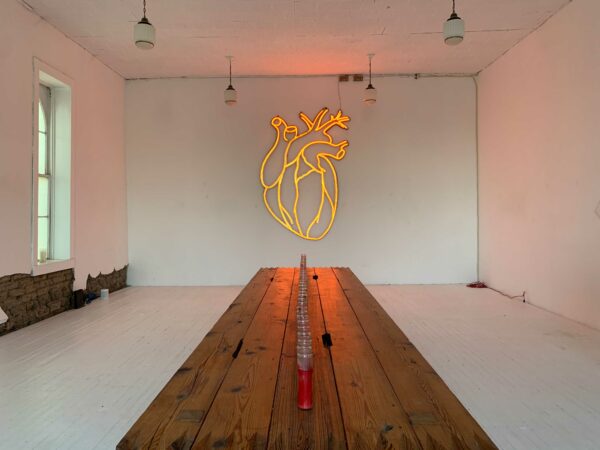
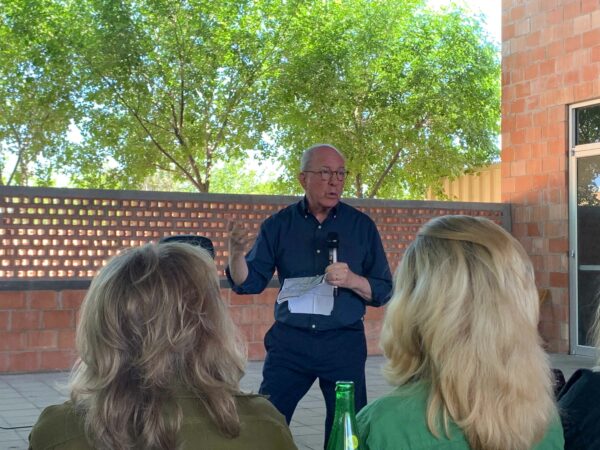

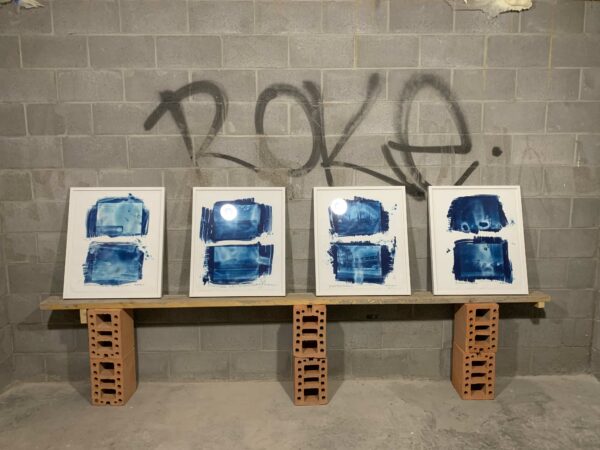
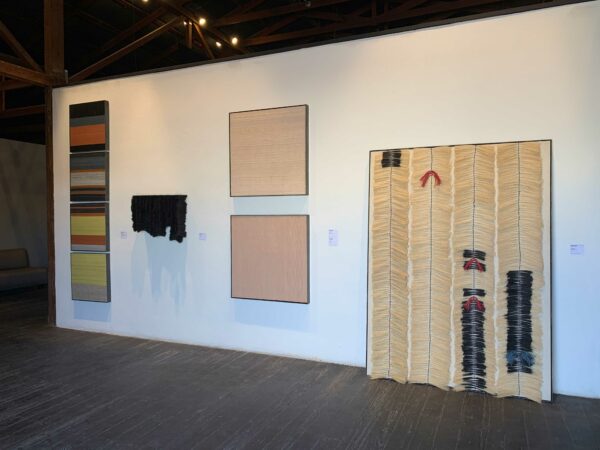

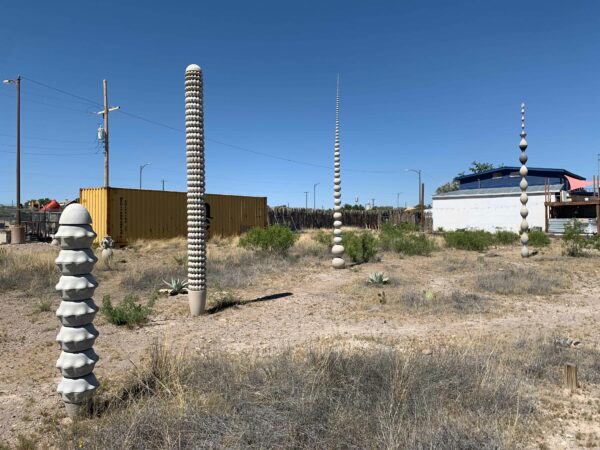

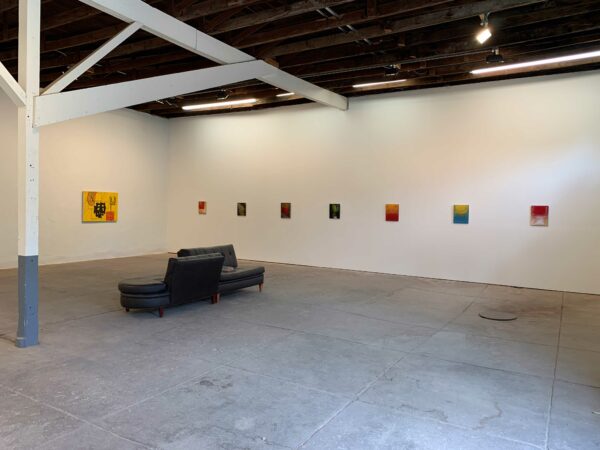
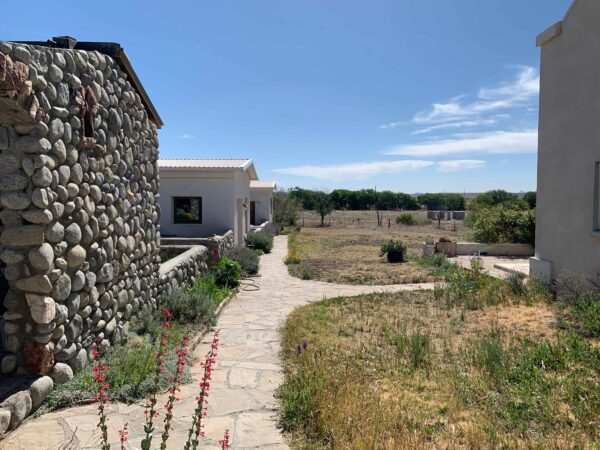
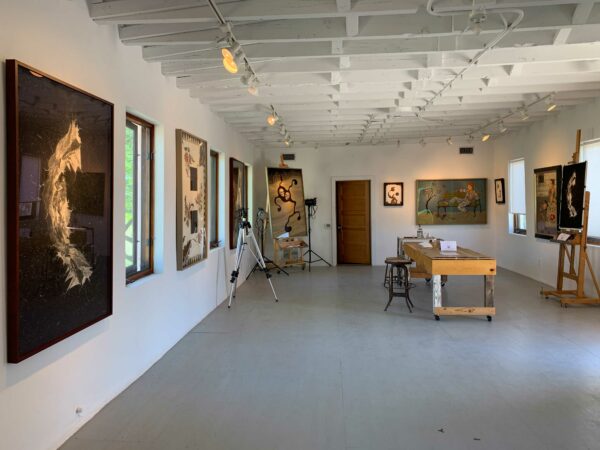
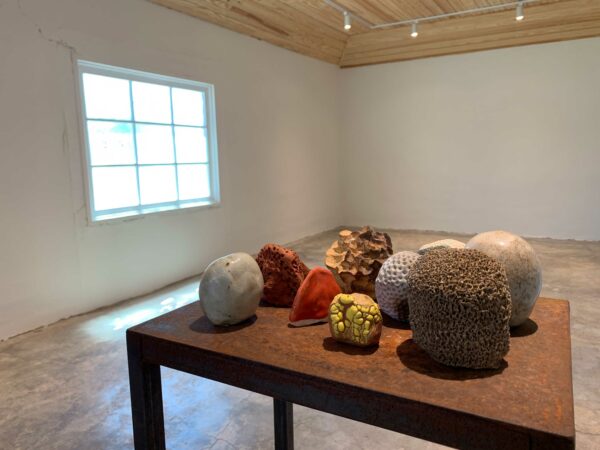
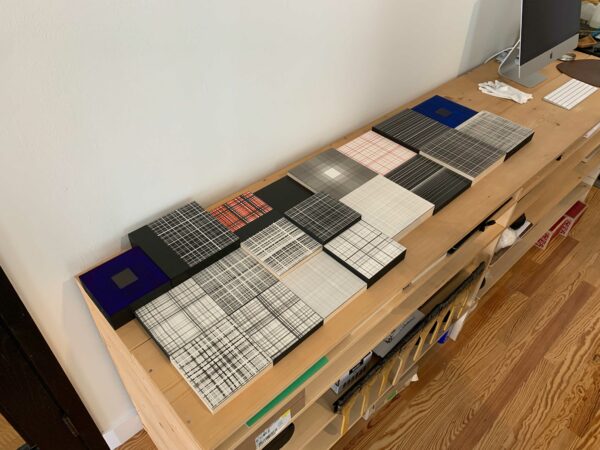
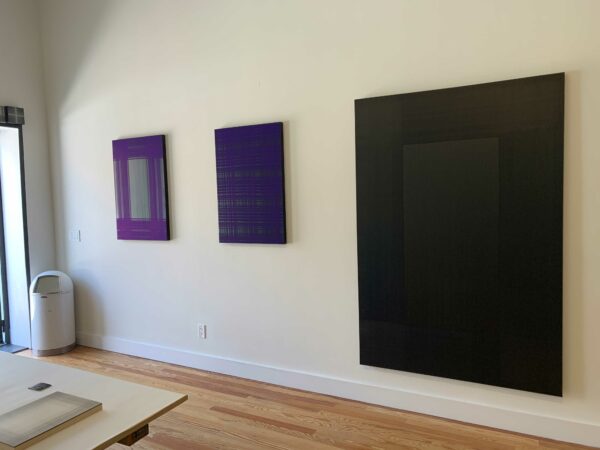



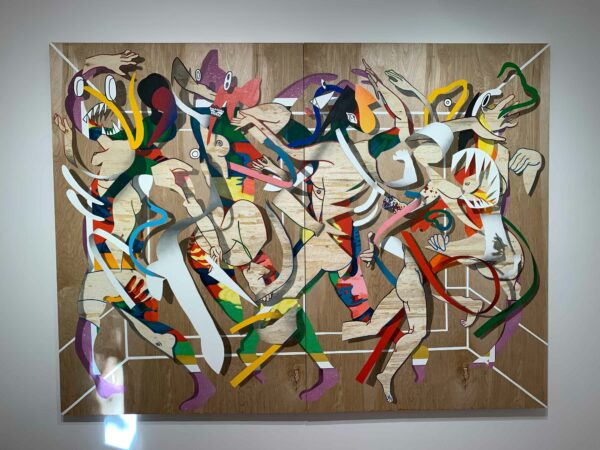
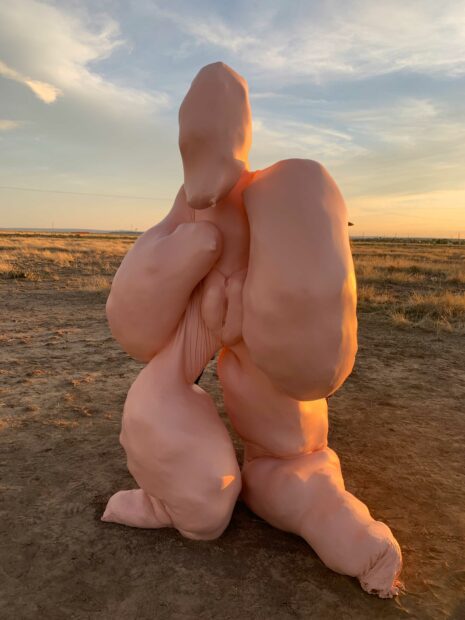
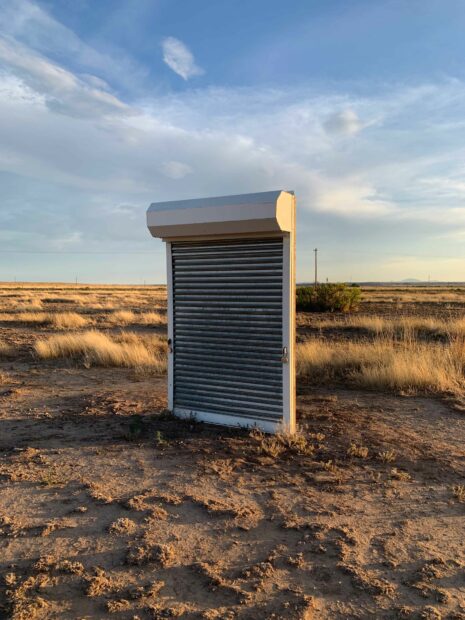
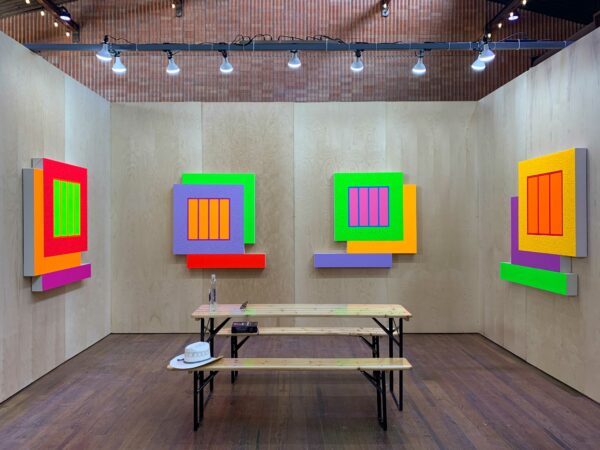
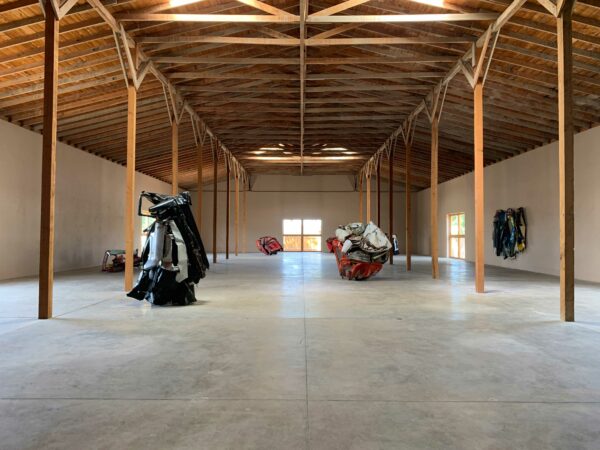
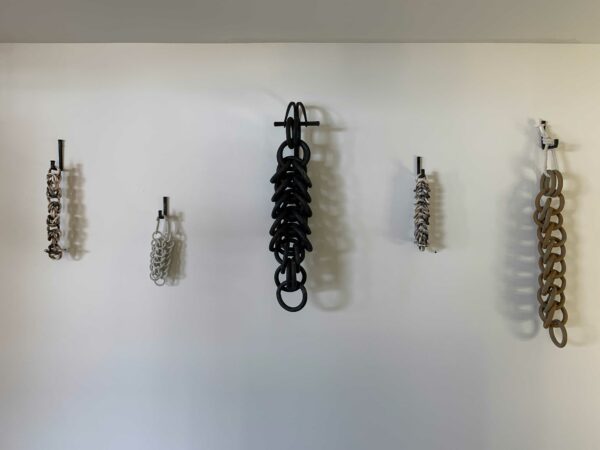

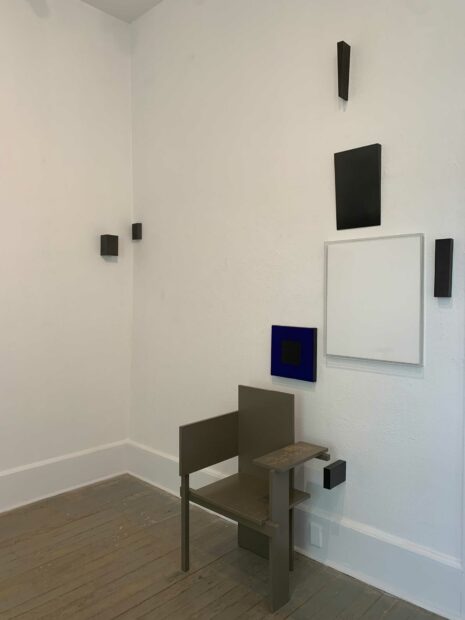
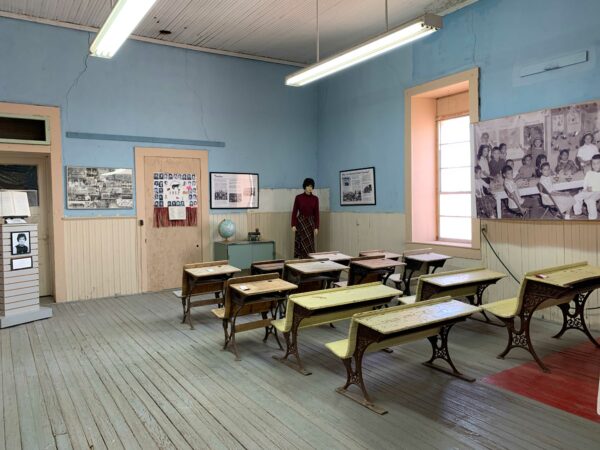


2 comments
Great recap of your Marfa trip! While visiting NYC last week, my itinerary included a trip to the Nino Mier Gallery in Soho to see an exhibition by Senegalese artist Seyni Awa Camara. Imagine my surprise upon seeing other Nino Mier Gallery locations pasted on the wall at the entrance – including Marfa, Texas. Another reminder of the powerful connection between NYC and Marfa.
I’m exhausted, just reading about your visit to Marfa. But it did open up some new places for my wife and me to visit on our annual Labor Day trip there. Thanks.